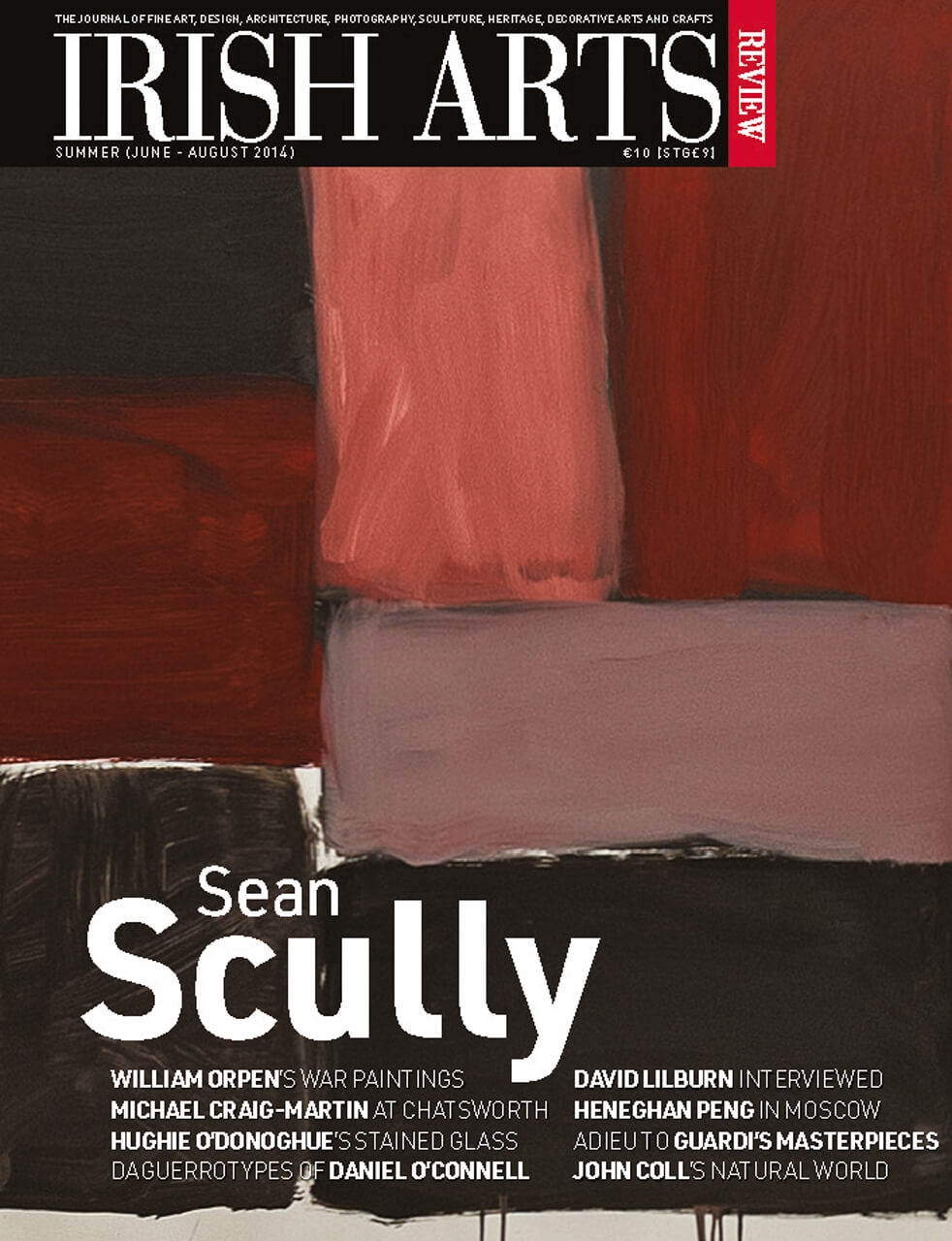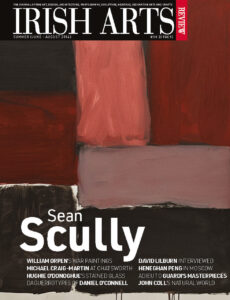

Former marine biologist John Coll turned to sculpture in order to enhance his understanding of nature, writes Gerry Walker
John Coll’s sculpture studio in Dublin’s north inner city is a large repository of finished works and works-in-progress full of found objects waiting to be studied and used as starting points for new projects. Situated beside the Liffey it is a far remove from his origins in Galway and the wild Atlantic coastal environs, which he explores so assiduously.
Born in 1959 he started his career as a marine biologist having qualified at Galway University and worked at that profession for a number of years. He developed an interest in art at university when he first read the letters of Vincent van Gogh and found personal resonances in the feeling for nature, which Van Gogh had described to his brother Theo. These simple yet profound expressions of reverence for nature found full and easy expression in Van Gogh’s paintings and at that point in his career Coll understood that he wanted to enhance his scientific appreciation of the natural world by using artistic media. This realization provides an insight into understanding what informs his work today. He first studied art at the Galway-Mayo Institute of Technology (GMIT) and followed up with a further year of learning the craft of welding in all its forms under the auspices of what was then known as AnCo, the State-run vocational training facility.
The natural world, particularly the marine environment, is the main arena within which he sources and creates his material, but an interest in history provides a backdrop to another genre interest of his – portraiture. Portraiture makes particular demands on an artist. There is a school of thought which suggests that a portrait says more about the artist than the subject. Further there is a distinction to be made between an artist who makes portraits and a portraitist. The main point at issue here is the artistic imperative to convey character rather than settle for mere likeness. Interestingly Coll talks about unmasking the ‘texture’ of a person when describing his working engagement with his subject. His studies in natural forms are testament to an ecological stance which counsels conservation of what we have before it is too late. The inherent message seeks to uncover and redefine our engagement with the natural world. His largely urban figurative portraits are both celebratory and commemorative. They aim to make history visible and to rekindle our interest and understanding of our shared past.
Both creative streams are linked in the sense that they clearly articulate a scientist’s interest in how we learn things and illustrate that we begin to learn and understand the moment we make our experience conscious. The psychiatrist and psychotherapist, Carl Jung, took the view that until we make the unconscious conscious it will direct our lives and we will call it fate. This is a view that must impact profoundly on us as viewers and consumers of public art. A shared environment and history are prerequisites for establishing and maintaining cultural consensus and cohesion. The artist becomes the conduit to a tribalized identity, which, if it is healthy, sustains and develops. Thus Coll’s work is celebratory not merely of our natural environment and our great historical and contemporary cultural practitioners but it also provides a range of subtext reassurances, which establish and guarantee our cultural credibility as a whole. Coll is immensely respectful of the legacy of history in general and art history in particular.
He has had many sculptural influences. John Behan was particularly instructive and helpful to him at the onset of his career. He admires Behan’s technical ability and his empathetic strength. Henry Moore was also significant in providing a basis for an appreciation of natural form, scale and a definition of monumentality. What has been described as the organic school of British sculpture appealed to his inner beachcomber and explains the presence in his work of found objects or their fabricated derivatives. So also did the work of Italian sculptor Marino Marini which portrayed an assertive naturalistic humanism, harking back to the Renaissance. This goes some way towards establishing Coll’s wider international context and also informs his overall attitude to the function of Public sculpture today. History and tradition offer guidelines which inform the principles of state, commercial or private, commissioning. However he inclines towards the view that today the first two categories can be problematic in that issues of restrictions of funding (the one per cent provision for art on building projects is capped), composition of selection committees (artists not represented adequately) and limitations on scale and siting (outdated planning laws), can all combine to have a deleterious effect on the quality of Irish public sculpture. This is a concern shared by many of his contemporaries.
Coll sees himself as a modeller rather than a carver. As a fabricator he asserts his preference for the additive as opposed to a subtractive process. His medium of choice is clay. It is primary and immediate. Using modelling clay as a base, he creates forms that can be developed in secondary materials such as bronze or stainless steel. This is exemplified in his 1991 canal-side depiction of the poet Patrick Kavanagh. He chose bronze because of its malleability where previously he found this quality lacking in stainless steel. Bronze facilitated greater expression of texture in terms of both material and persona. This is a commemorative portrait whose traditional expression of monumentality has been recast to evoke the relaxed demeanor of Kavanagh (Fig 5). It is part of a genre, which echoes Hellenistic sculptural forms in that it both downplays and emphasizes detail in order to enhance creative impact. One of the members of the commissioning committee had been Kavanagh’s tailor. He was able to provide Coll with detailed measurements, down to the poet’s collar size. This, according to the sculptor, was critical in determining not so much the likeness as ‘the texture of the man’. Here one feels that he would be entirely in sympathy with Moore when the latter noted that the difference between modelling and carving was that modelling was a quicker process – more amenable to the elimination of surplus ideas. The fact that the figure has been released from a pedestal and situated on a park bench has undoubtedly enhanced its vernacularity and its accessibility.
A recent portrait bust of poet Seamus Heaney is a remarkable blend of the traditional and the experimental (Fig 7). Its interest lies not only in its conceptual iconography – a bronze winged head evocative of imaginative flights of inspiration and creativity – but also in Coll’s technique which involves ‘modelling’ with varying gauged welding rods. The effects of burnishing highlights and the corrosive effects of time and siting ensure an evolving ‘textural’ expression which in theory will change and delight continuously. His earlier nature-phase works, rendered in stainless steel in the main, best describe his essentialist personal aesthetic. Coll has developed an exceptional skill base in his use of stainless steel. He can weld stainless steel with such proficiency that it emulates the malleable characteristics of cast bronze and yet retains its own unique attributes. Different media enable different possibilities as is apparent in the delicacy and precision manifest in his Tern Lunchtime (Fig 2). The bird form is in itself a structured response to evolutionary imperatives: It has a fitness for purpose profile, which represents a sublime expression of formal achievement. Media diversity also determines stylistic treatment. Coll does not have a uniform approach to style as becomes apparent in a work entitled Craiceann (Fig 1). This word translates as ‘skin’ in Gaelic, and depicts the conjunction of a basking shark and a traditional Connemara curragh. The fabrication materials employed are wood, canvas and tar. The curragh form is an evolved design and resulted from a set of functionalist requirements which sought to minimize environmental friction and enhance elemental compatibility in order to function to optimal levels. The same principles apply to the form of the basking shark. The animate and the inanimate share a common skin made from canvas and tar and this device articulates their common characteristics and inherent relatedness. The theme of appropriate and necessary form is continued in an intensely detailed, relatively small rendition of a tree constructed with the use of different gauges of bronze welding rods. Here Coll has used a technique which is effectively a process of drawing in space with a welder. Exuding forcefulness and immediacy, it is a lyrical expression of the concept of ‘grace under pressure’. Entitled Sceach an Eolais, it represents a tree of knowledge blossoming with the accoutrements of learning and academia (Fig 4). The piece was presented to An tUachtaran Michael D Higgins.
In the 1940s when Herbert Read encapsulated the functionalist ethic as ‘Fitness for function is the modern definition of the eternal quality we call beauty‚Ķ and is the inevitable result of an economy directed to use and not to profit’, he was identifying an innate natural principle which recognized our attraction to and appreciation of elements which exist, sustain and evolve in a manner which is determined by economy, efficiency and spareness. In Nature as in Art, less is more. What Coll has recognized and manages to capture in his work is an immediate expression of necessary form. The magic lies not in the appearance but in the essential.
Gerry Walker is a writer and a critic and a regular contributor to Irish Arts Review.



